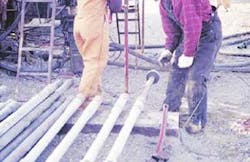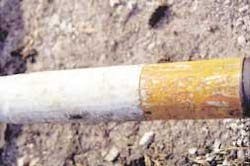A new lightweight, jointed, flexible drill pipe engineered from space-age composites rather than steel passed important field tests, according to the US Department of Energy's National Energy Technology Laboratory (DOE-NETL).
DOE-NETL provided financial assistance for developing and commercializing this composite drill pipe with steel connections.
The rig crew is picking up the carbon-fiber pipe for drilling the build section in an Oklahoma short-radius test (Fig. 1). Photo courtesy of ACPT.
Advanced Composite Products and Technology Inc. (ACPT), Huntington Beach, Calif., produces the carbon-fiber resins in the pipe.
Pipe status
Jim Heard, director of marketing for ACPT, expects the 21/2-in. OD pipe with 33/8-in. heat-treated steel tool joints to be commercially ready by the end of April 2003. The pipe comes in 30-ft lengths and weighs about 3 lb/ft—lighter than comparable steel pipe.
He said that a version with a 51/2-in. OD and 7-in. tool joints, aimed for deepwater applications, should be ready for its first field tests also by the end of April.
After use, the carbon-fiber pipe showed some rust on the steel tool joint but only a few scratches on the composite (Fig. 2). Photo courtesy of ACPT.
In deepwater drilling, drill pipe weight is important because a lighter drill pipe translates into less torque and drag, so that a well can be drilled to greater depth both vertically and horizontally.
Tulsa County test
Grand Resources Inc., Tulsa, used the pipe to drill short 70-ft radius buildportions for horizontal laterals in two wells at Bird Creek field, Tulsa County, Okla. Both wells originally were completed with 51/2 in. casing in the early 1920s.
Scott Robinowitz, vice-president of Grand Resources, said the first well did not have problems with the carbon-fiber pipe but the second well encountered difficulties with the tool-joint connections. He said the manufacturer was working on solving the problem.
The drilling included rotary-steerable tools with 41/2 in. polycrystalline-diamond compact bits on the carbon-fiber pipe for drilling the build-section and a short portion of the horizontal lateral, 30 ft in one well and 60 ft in the other. Grand Resources drilled the remaining 1,000 ft lateral with standard steel drill pipe and 4 in. air-hammer tools that beat at 2,400 spm with a 4-6 in. stroke.
Both laterals are at a 1,290 ft depth.
Robinowitz said that at the end of January 2003, production from the first well amounted to 12 bo/d, and completion of the second well was continuing.
DOE said the flexible composite drill pipe overcomes the problem encountered when using steel pipe to drill high-build laterals. Although more expensive than a traditional steel pipe, DOE said the carbon-fiber pipe can remain bent for extended periods of time without suffering fatigue damage.
It, therefore, expects a significant decrease in drilling costs because of fewer pipe failures, the need for less pipe because of the shortened radius, and the ability to drill more wells with a single pipe string.
Fig. 1 shows a crew picking up the carbon-fiber pipe. Fig. 2 shows some rust on the steel tool joint but only a few scratches on the composite after the use of the pipe.

